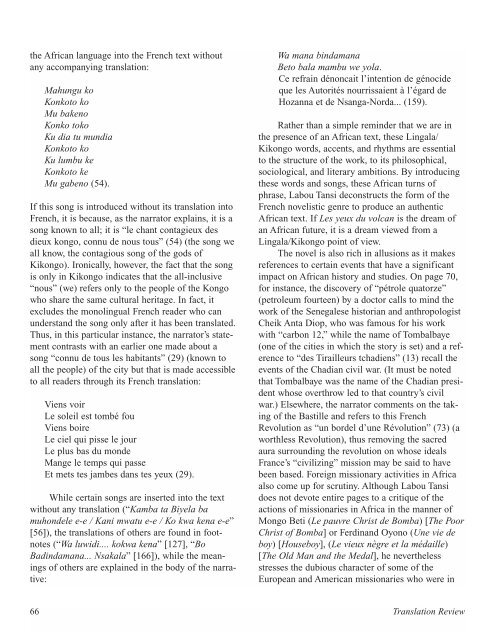Translation Review - The University of Texas at Dallas
Translation Review - The University of Texas at Dallas
Translation Review - The University of Texas at Dallas
Create successful ePaper yourself
Turn your PDF publications into a flip-book with our unique Google optimized e-Paper software.
the African language into the French text without<br />
any accompanying transl<strong>at</strong>ion:<br />
Mahungu ko<br />
Konkoto ko<br />
Mu bakeno<br />
Konko toko<br />
Ku dia tu mundia<br />
Konkoto ko<br />
Ku lumbu ke<br />
Konkoto ke<br />
Mu gabeno (54).<br />
If this song is introduced without its transl<strong>at</strong>ion into<br />
French, it is because, as the narr<strong>at</strong>or explains, it is a<br />
song known to all; it is “le chant contagieux des<br />
dieux kongo, connu de nous tous” (54) (the song we<br />
all know, the contagious song <strong>of</strong> the gods <strong>of</strong><br />
Kikongo). Ironically, however, the fact th<strong>at</strong> the song<br />
is only in Kikongo indic<strong>at</strong>es th<strong>at</strong> the all-inclusive<br />
“nous” (we) refers only to the people <strong>of</strong> the Kongo<br />
who share the same cultural heritage. In fact, it<br />
excludes the monolingual French reader who can<br />
understand the song only after it has been transl<strong>at</strong>ed.<br />
Thus, in this particular instance, the narr<strong>at</strong>or’s st<strong>at</strong>ement<br />
contrasts with an earlier one made about a<br />
song “connu de tous les habitants” (29) (known to<br />
all the people) <strong>of</strong> the city but th<strong>at</strong> is made accessible<br />
to all readers through its French transl<strong>at</strong>ion:<br />
Viens voir<br />
Le soleil est tombé fou<br />
Viens boire<br />
Le ciel qui pisse le jour<br />
Le plus bas du monde<br />
Mange le temps qui passe<br />
Et mets tes jambes dans tes yeux (29).<br />
While certain songs are inserted into the text<br />
without any transl<strong>at</strong>ion (“Kamba ta Biyela ba<br />
muhondele e-e / Kani mw<strong>at</strong>u e-e / Ko kwa kena e-e”<br />
[56]), the transl<strong>at</strong>ions <strong>of</strong> others are found in footnotes<br />
(“Wa luwidi.... kokwa kena” [127], “Bo<br />
Badindamana... Nsakala” [166]), while the meanings<br />
<strong>of</strong> others are explained in the body <strong>of</strong> the narr<strong>at</strong>ive:<br />
Wa mana bindamana<br />
Beto bala mambu we yola.<br />
Ce refrain dénoncait l’intention de génocide<br />
que les Autorités nourrissaient à l’égard de<br />
Hozanna et de Nsanga-Norda... (159).<br />
R<strong>at</strong>her than a simple reminder th<strong>at</strong> we are in<br />
the presence <strong>of</strong> an African text, these Lingala/<br />
Kikongo words, accents, and rhythms are essential<br />
to the structure <strong>of</strong> the work, to its philosophical,<br />
sociological, and literary ambitions. By introducing<br />
these words and songs, these African turns <strong>of</strong><br />
phrase, Labou Tansi deconstructs the form <strong>of</strong> the<br />
French novelistic genre to produce an authentic<br />
African text. If Les yeux du volcan is the dream <strong>of</strong><br />
an African future, it is a dream viewed from a<br />
Lingala/Kikongo point <strong>of</strong> view.<br />
<strong>The</strong> novel is also rich in allusions as it makes<br />
references to certain events th<strong>at</strong> have a significant<br />
impact on African history and studies. On page 70,<br />
for instance, the discovery <strong>of</strong> “pétrole qu<strong>at</strong>orze”<br />
(petroleum fourteen) by a doctor calls to mind the<br />
work <strong>of</strong> the Senegalese historian and anthropologist<br />
Cheik Anta Diop, who was famous for his work<br />
with “carbon 12,” while the name <strong>of</strong> Tombalbaye<br />
(one <strong>of</strong> the cities in which the story is set) and a reference<br />
to “des Tirailleurs tchadiens” (13) recall the<br />
events <strong>of</strong> the Chadian civil war. (It must be noted<br />
th<strong>at</strong> Tombalbaye was the name <strong>of</strong> the Chadian president<br />
whose overthrow led to th<strong>at</strong> country’s civil<br />
war.) Elsewhere, the narr<strong>at</strong>or comments on the taking<br />
<strong>of</strong> the Bastille and refers to this French<br />
Revolution as “un bordel d’une Révolution” (73) (a<br />
worthless Revolution), thus removing the sacred<br />
aura surrounding the revolution on whose ideals<br />
France’s “civilizing” mission may be said to have<br />
been based. Foreign missionary activities in Africa<br />
also come up for scrutiny. Although Labou Tansi<br />
does not devote entire pages to a critique <strong>of</strong> the<br />
actions <strong>of</strong> missionaries in Africa in the manner <strong>of</strong><br />
Mongo Beti (Le pauvre Christ de Bomba) [<strong>The</strong> Poor<br />
Christ <strong>of</strong> Bomba] or Ferdinand Oyono (Une vie de<br />
boy) [Houseboy], (Le vieux nègre et la médaille)<br />
[<strong>The</strong> Old Man and the Medal], he nevertheless<br />
stresses the dubious character <strong>of</strong> some <strong>of</strong> the<br />
European and American missionaries who were in<br />
66 <strong>Transl<strong>at</strong>ion</strong> <strong>Review</strong>

















